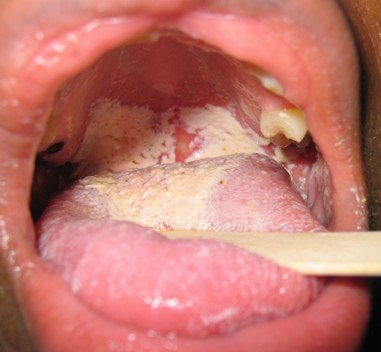A nurse is caring for a school-age child who has a systemic disorder and is
receiving antibiotics, immunosuppressants, and corticosteroids. Both of the child's parents have a smoking history.
The child reports soreness in his mouth and refuses to eat.
Inspection of his mouth reveals a white, milky plaque that does not come off with
rubbing.
The nurse should suspect which of the following conditions?
Dermatitis
Candidiasis
Herpes simplex
Squamous cell carcinoma.
The Correct Answer is B
The nurse should suspect candidiasis, also known as oral thrush.
Candidiasis is a fungal infection that can occur in the mouth and is characterized by the presence of a white, milky plaque that does not come off with rubbing.
The child’s use of antibiotics, immunosuppressants, and corticosteroids can increase the risk of developing candidiasis.
Choice A is incorrect because dermatitis is an inflammation of the skin and
would not present as a white plaque in the mouth.
Choice C is incorrect because herpes simplex typically presents as painful blisters or sores in the mouth.
Choice D is incorrect because squamous cell carcinoma typically presents as a firm, painless growth, or ulcer in the mouth.

Nursing Test Bank
Naxlex Comprehensive Predictor Exams
Related Questions
Correct Answer is D
Explanation
The nurse should first offer the mother's private time with the newborn to allow her to grieve and say goodbye.
This can be an important part of the healing process for the mother.
Choice A is not an answer because contacting clergy is not the first action the nurse should take.
Choice B is not an answer because transferring the client to another unit is not the first action the nurse should take.
Choice C is not an answer because administering medication is not the first action the nurse should take.
Correct Answer is C
Explanation
Activated charcoal should be given as soon as possible to help absorb the acetylsalicylic acid in the gastrointestinal tract.
Choice A is not an answer because N-acetylcysteine is used to treat acetaminophen overdose, not acetylsalicylic acid overdose.
Choice B is not an answer because chelation therapy with deferoxamine is used to treat iron poisoning, not acetylsalicylic acid overdose.
Choice D is not an answer because inducing vomiting with syrup of ipecac is no longer recommended for the treatment of poisoning due to the potential for harm and lack of evidence of benefit.
Whether you are a student looking to ace your exams or a practicing nurse seeking to enhance your expertise , our nursing education contents will empower you with the confidence and competence to make a difference in the lives of patients and become a respected leader in the healthcare field.
Visit Naxlex, invest in your future and unlock endless possibilities with our unparalleled nursing education contents today
Report Wrong Answer on the Current Question
Do you disagree with the answer? If yes, what is your expected answer? Explain.
Kindly be descriptive with the issue you are facing.
